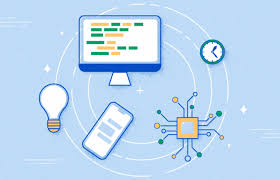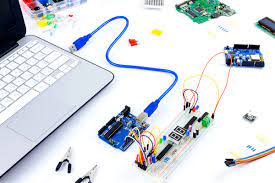
A Webinar on “EMBEDDED SOFTWARE DEVELOPMENT”
What is an Embedded System?
The term "embedded system" refers to a combination of computer software and hardware that is either fixed or programmable in capacity. An embedded system can be a stand-alone system or a component of a larger system. It's usually made for a single function or set of functions within a bigger system. A Temperature sensor, for example, is a common example of an embedded device that can only detect Temperature.
History of Embedded system:
* In 1960, embdded system was first used for developing Apollo Guidance System by Charles Stark Draper at MIT.
* In 1965, Autonetics, developed the D-17B, the computer used in the Minuteman missile guidance system.
* In 1968, the first embedded system for a vehicle was released.
* Texas Instruments developed the first microcontroller in 1971.
* In 1987, the first embedded OS, VxWorks, was released by Wind River.
* Microsoft's Windows embedded CE in 1996.
* By the late 1990s, the first embedded Linux system appeared.
* The embedded market reach $140 billion in 2013.
* Analysts are projecting an Embedded market larger than $40 billion by 2030.
Characteristics of an Embedded System
* Requires real time performance
* It does not need any secondary memory in computer.
* Limited memory, low cost, fewer power consumptions
* Needed minimal user interface
* Offers high reliability and stability
* It must be connected with peripherals to connect input and output devices.
*It should have high availability and reliability.
* Developed around a real-time operating system
* Usually, have easy and a diskless operation, ROM boot and Designed for one specific task.

Important terminologies used in embedded system
Reliability: This is a measure of the system's chances of surviving when the function is important during the run period.
Fault-Tolerance: The ability of a computer system to endure in the presence of problems is known as fault tolerance.
Real-Time:The embedded system must adhere to a number of time and other constraints. They are forced on it by the external world's real-time natural activity.
Flexibility:It's designing systems that have built-in debugging capabilities, allowing for remote maintenance.
Portability:The ease with which the same embedded software can be used in different environments is known as portability. It necessitates the creation of generic abstractions between application programme logic and low-level system interfaces.
What is Microcontroller & Microprocessor?
A microcontroller, commonly known as a microcomputer, is a single-chip VLSI device. It has all of the essential memory and I/O ports, whereas a general-purpose CPU requires extra chips to provide these functionalities. In embedded systems, microcontrollers are commonly employed for real-time control applications.A microprocessor is a semiconductor device with a single chip. A programme counter, an ALU, a stack pointer, a working register, and a clock timing circuit are all part of the CPU. It also has ROM and RAM, as well as a memory decoder and numerous serial and parallel connectors.
A basic Architecture of the Embedded System

1) Sensor: A sensor is a device that helps you measure physical quantities and converts them to electrical signals. It also saves the quantity measured in memory. An observer or any electronic instrument, such as a computer, can prepare this signal.
2) A-D Converter: An A-D converter (analog-to-digital converter) transforms an analogue signal from a sensor into a digital signal.
3) Memory: Memory is a type of storage device. Two memory cells make up the majority of an embedded system. 1) Volatile 2) Non volatile memory.
4) Processor & ASICs: This component processes the data to measure the output and store it to the memory
5) D-A Converter: D-A converter (A digital-to-analog converter) helps you to convert the digital data fed by the processor to analog data.
6) Actuator: An actuator compares the D-A converter's output to the actual output stored in the actuator and records the approved output in the memory.
Embedded Software Development Tools:
1) PyCharm: JetBrains, a Czech startup, built this IDE exclusively for Python coders. PyCharm, on the other hand, is well-suited to cross-platform development, as it supports JavaScript, CoffeeScript, TypeScript, Cython, SQL, HTML/CSS, AngularJS, Node.js, template languages, and more, as well as Windows, macOS, and Linux.
2) MPLAB X: MPLAB X is the most recent version of Microchip Technology's MPLAB integrated development environment. The software is built on the open-source NetBeans platform and is intended for use with PIC microcontrollers and digital signal controllers of various types.
3) Visual studio: Visual Studio, a prominent integrated development environment from Microsoft, is used to create not only computer programmes and mobile apps, but also embedded software. Programmers can debug native C/C++ code on Windows, microcontrollers, or remote Linux workstations using the Visual C++ for IoT development extension.Using Visual Studio for IoT, you can build, edit and debug devices running on Linux.
4) MATLAB: MATLAB is a software package that includes tools and a programming language for numerical computing. MATLAB is used by developers in a variety of fields to construct user interfaces, implement algorithms, and work with data plots, functions, matrices, and graphs, among other things. Interfacing with applications written in C, C++, C#, Java, Python, and other languages is possible in this environment. : Visual Studio, a prominent integrated development environment from Microsoft, is used to create not only computer programmes and mobile apps, but also embedded software. Programmers can debug native C/C++ code on Windows, microcontrollers, or remote Linux workstations using the Visual C++ for IoT development extension.
5) Arduino:Arduino is an open-source IDE that aids in the development of programmes for Arduino microcontrollers. It includes a number of features and libraries that make embedded programmers' lives easier.
6) ARM Keil: The ARM Keil development tools offer a full environment for developing embedded applications for a wide range of ARM-based devices. Leading C/C++ compilers, simulation models, debuggers, linkers, assemblers, and middleware libraries are all included in the software bundle.
Advantages of Embedded System
It can be used in a wide range of situations, Errors are less likely to repeat and The Embedded System simplifies hardware, lowering overall expenses.
Provides improved performance, For mass production, the embedded system is useful, The embedded system has a high level of dependability, It has a small number of interconnections.















Comments
Crapersoft, well knowledged in Bigdata, datamining and iot working environment in coimbatore.
Replygot good website... with advanced technologies...
ReplyI have published my research paper to Scopus at short duration thanks to help of crapersoft.
Reply